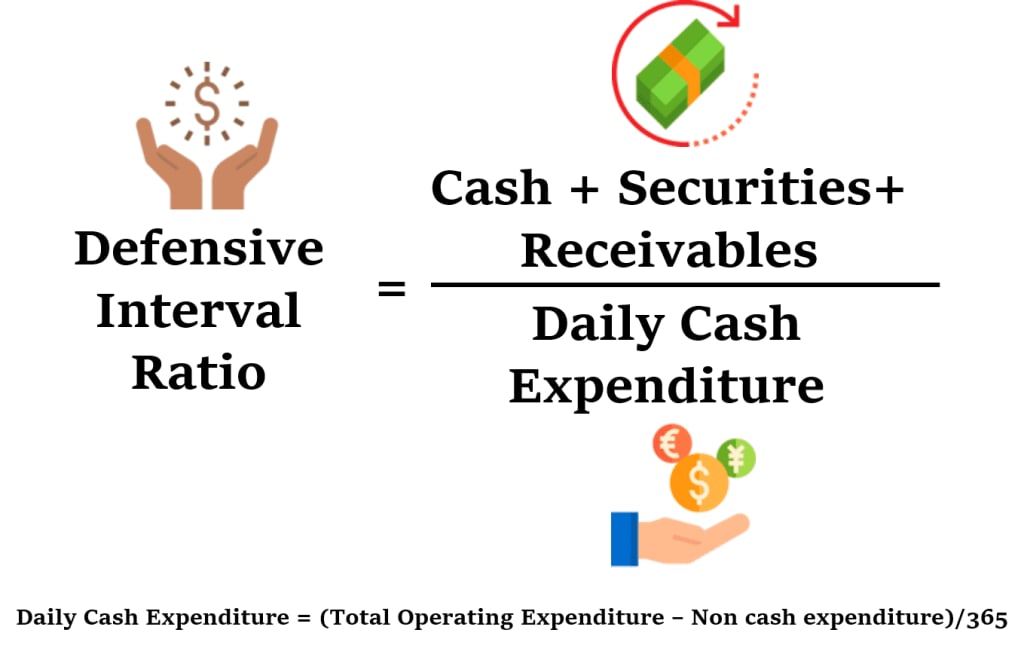Understanding Defensive Interval: How Businesses Manage Debts
Explained with a Kid-Friendly Example of a Lemonade Stand Business

Defensive Interval: Protecting Your Investments with a Simple Example
Investing can be a great way to grow your money, but it also comes with risks. As a kid, it's important to understand how to protect your investments and make informed decisions. One concept that can help you with that is the defensive interval. In this article, we will explore what the defensive interval is, why it matters, and provide a simple example to help you understand it better.
What is Defensive Interval?
Defensive interval is a financial metric used by investors to assess the resilience of a company's business model and its ability to withstand economic downturns. It is a measure of how well a company can defend itself against competition and generate sustainable profits. In other words, it's a way to evaluate how "defensive" a company's operations are in protecting its earnings and cash flows.
The defensive interval is calculated by dividing a company's total assets (excluding goodwill and other intangible assets) by its total liabilities. It provides an estimate of the number of years a company can cover its liabilities using its operating income alone, without relying on external financing or additional capital injections.
A high defensive interval indicates that a company has a strong competitive position, generating sufficient earnings to cover its liabilities for a longer period of time. On the other hand, a low defensive interval may indicate that a company is more vulnerable to economic downturns or competition.
Example of Defensive Interval
Let's say you have a lemonade stand business. You have total assets (such as your lemonade stand, equipment, and inventory) worth $500, and total liabilities (such as debts or loans) amounting to $200. Your operating income, which is the money you make from selling lemonade, is $100 per year.
Using the formula for defensive interval, we can calculate it as:
Defensive Interval = Total Assets / Total Liabilities
Defensive Interval = $500 / $200
Defensive Interval = 2.5
This means that your lemonade stand business has a defensive interval of 2.5 years. It can cover its liabilities (debts) for 2.5 years using its operating income (earnings) alone, without relying on external financing.
Why is Defensive Interval Important?
The defensive interval is an important metric for investors as it provides insights into a company's ability to withstand economic challenges and generate sustainable profits. A higher defensive interval indicates that a company has a strong competitive position, which can be a positive indicator for long-term investment prospects. It suggests that the company has a solid business model that can generate consistent earnings and cash flows, making it less vulnerable to economic downturns or competition.
On the other hand, a lower defensive interval may indicate that a company is more dependent on external financing or has weaker earnings relative to its liabilities. This could raise concerns about the company's ability to sustain its profitability and manage its debts, which may pose risks to investors.
Summarise
Imagine you have a lemonade stand business, and you want to know how long your business can cover its debts (like loans or bills) using only the money you make from selling lemonade. That's where the defensive interval comes in.
Let's say your lemonade stand has total assets worth $500, which includes your lemonade stand, equipment, and inventory. And you have total liabilities (debts) of $200, which includes money you owe to others.
Now, let's say your lemonade stand business makes $100 in operating income (earnings) per year from selling lemonade. You can use the defensive interval formula to calculate how long your business can cover its debts with its operating income:
Defensive Interval = Total Assets / Total Liabilities
Defensive Interval = $500 / $200
Defensive Interval = 2.5
So, your lemonade stand business has a defensive interval of 2.5 years. This means that it can cover its debts for 2.5 years using its operating income (earnings) alone, without relying on external financing.
A higher defensive interval, like in this example, indicates that your lemonade stand business is in a good position to cover its debts for a longer period of time, which is a positive sign for investors. It suggests that your business has a solid financial position and can generate consistent earnings, making it less vulnerable to economic challenges or competition.
On the other hand, a lower defensive interval may indicate that a business is more dependent on external financing or has weaker earnings relative to its debts, which could raise concerns about its financial strength.
Understanding the defensive interval can help you assess how well a business can manage its debts and generate sustainable profits, which is important for making informed investment decisions. By learning about financial concepts like the defensive interval from an early age, you can develop valuable skills to manage your money wisely and make sound financial decisions in the future.
In conclusion, understanding the defensive interval can help you make more informed investment decisions by evaluating the resilience and sustainability of a company's operations. It's important to consider multiple financial metrics and do thorough research before making any investment decisions, and defensive interval is one useful tool that can help you assess a company's financial strength. By learning about financial concepts like defensive interval from an early age, you can develop valuable skills to manage your investments wisely in the future.
About the Creator
Tag Business
I Will Providing Various Company Information






Comments
There are no comments for this story
Be the first to respond and start the conversation.